
The science of preserving nature since 1964
Please contact us for a FREE Consultation

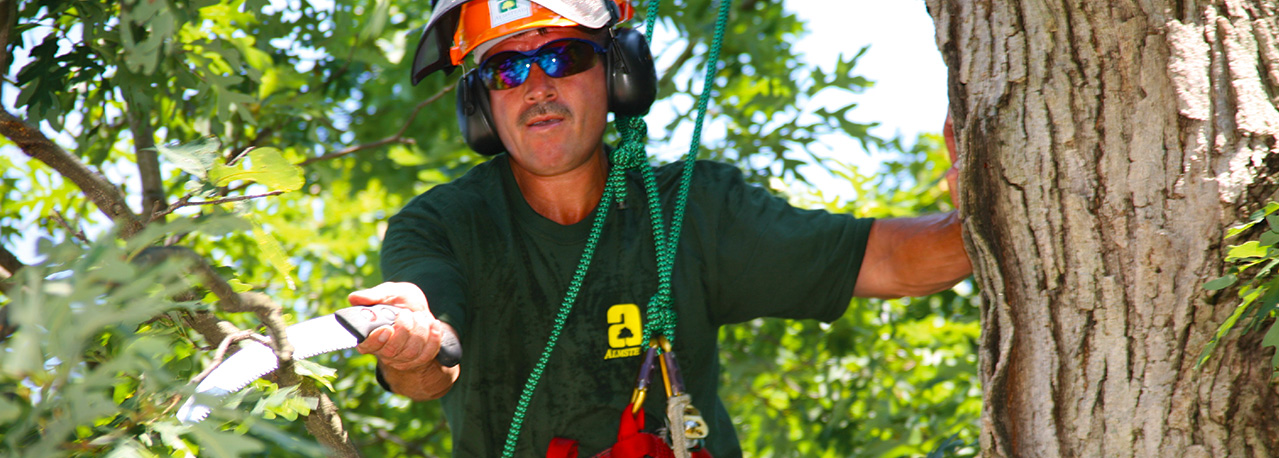
Tree Pruning
Pruning is one of the most common and essential tree maintenance procedures performed. Proper pruning, in general, helps maintain the health, safety, and beauty of trees...
Removing undesirable branches and twigs from a tree or shrub is know as pruning. It is important to know why, when and how to prune before you attempt to do it on your own.
Reasons For Pruning:
There are many reasons why a tree may need to be pruned:
- Storm-damaged or diseased branches may need to be taken out to prevent harmful insects from accessing the tree -- or because it is unsafe for people and property.
- The height of the tree may need to be reduced.
- The crown may need to be thinned to increase air and sunlight coming in so growth is more robust and the tree is less prone to disease.
- Crossing branches that rub against one another may need to be pruned so they don’t rub against each other.
- V-shaped crotches in branches split apart as trees grow older and may need to be removed before they break apart.
- Co-dominant branches may need to be reduced to just one branch so it grows stronger. The smaller branch should be removed and the larger branch allowed to grow.
- Low-growing branches that pose a threat to people and property may need to be removed.
- Branches that grow much faster than the others may need to be pruned so the natural structure of the tree is maintained.
- Pruning stimulates growth in areas of the tree that are sparse.
- Trees can also be pruned to create a more aesthetic landscape or to reveal scenic views of a lake, etc.
When To Prune:
The ideal time for pruning can vary according to species, as well as on the reason for pruning. However, here are some general guidelines:
- Dead and diseased branches should be removed as soon as possible.
- A good time to prune trees and shrubs is late-winter/early-spring – when buds begin to open.
- Some trees, such as birches, dogwoods, maples, and elms, bleed sap so it may be better to prune these when they are dormant, in winter.
- Winter pruning or dormant pruning can stop the spread of some diseases and fungi in certain species of trees.
- Winter is also a good time to prune because when there are no leaves the structure of the tree can be seen more clearly.
- Access for trucks and equipment is easier in winter when the ground is frozen and there is less chance of damaging the surrounding landscape.
- Professional tree service companies charge less for pruning in winter because it is easier to access the tree and cleanup takes less time.
- Pruning in fall should be done only if it is necessary because it may stimulate new growth while the tree is preparing to enter its dormant stage for winter. It may be better to wait until the tree is fully dormant.
How To Prune:
Before you prune your trees and shrubs yourself, make sure it's something you can do on your own. If it is a job that requires a chain-saw, ladder work, or more, you should consider hiring a professional, like Almstead, to do your pruning. Here are the basics of pruning which may useful information, even if you are hiring someone else.
- The first thing to do is to determine what needs to be pruned in a tree -- this will determine your strategy and the tools required.
- The main tools used in pruning are hand pruners, loppers and a pruning saw. Professionals also use pole saws, chain saws and hydraulic lifts.
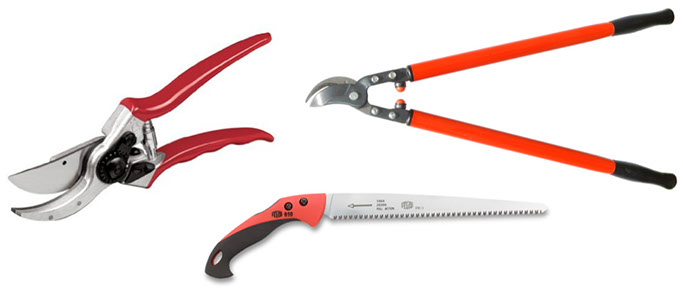
Bypass Pruners – good to cut small branches approximately ½ to ¾ inch in diameter.
Loopers – designed to cut wood ¾ inch up to 1 ½ inch in diameter.
Pruning Saws – can easily cut wood up to 3” in diameter.
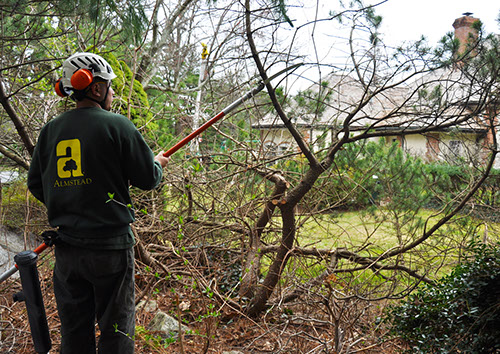
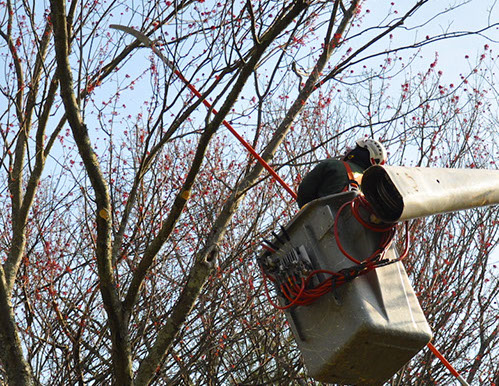
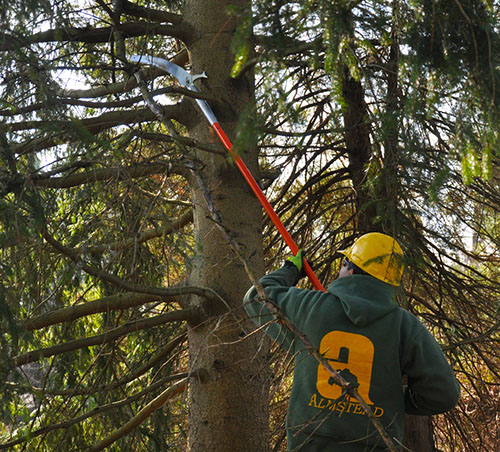
Hand-held pole saws and a hydraulic lift with a bucket are used to prune large trees. Safety is always an important issue -- note the helmets, gloves and safety goggles used by these Almstead technicians.
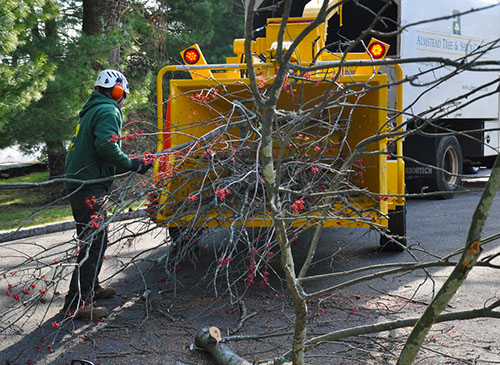
Clean-up and disposal is an important part of pruning large trees. Professional tree service companies, such as Almstead, use chain saws and wood chippers along with chip dump trucks to carry away the wood chips.
- When pruning diseased wood, always disinfect tools between each cut with denatured alcohol or bleach.
- When the branch of a tree is cut off, it does not grow back. Instead, the tree seals the wound and compartmentalizes it so it does not decay. It is important to prune correctly so wounds can be sealed. Cutting branches flush to the trunk or leaving stubs are examples of wrong pruning techniques. In both instances, the tree will be unable to seal the wound and the branch will rot. If you see decayed holes or seeping wounds in the trunk of a tree, you’re looking at the results of bad pruning.
- It is important to be able to identify and locate the branch collar (a swelling around the base of a branch), and the branch bark ridge (a slightly raised, dark, rough bark that forms where the branch and trunk tissue meet). Do not make any cuts in either of these areas. This is where the chemicals that protect the wound are contained.
- The 3-Cut Pruning Method is considered the safest and proper way to cut medium to large sized branches: The 1st cut is a small undercut that prevents bark stripping; the 2nd cut removes most of the weight of the limb; and the 3rd cut severs the branch just outside the branch collar.
Pruning Cuts:
There are generally three types of cuts used in arboricultural pruning:
Thinning Cut (Branch Removal Cut)
A Thinning Cut is the removal of the entire branch or limb at its base. Thinning cuts are employed to remove an entire limb or branch where crowding occurs. The cut should leave a smooth surface with no jagged edges or torn bark.
Reduction Cut (Lateral Cut)
This shortens a branch and is used when reducing the size of a tree. The remaining limb is capable of sustaining the parent branch. A common rule of thumb is to cut it to no less than a third of the removed portion. This will keep the limb alive and also suppress excessive sprouting in many species.
Heading Cut (Topping or Lopping Cut)
A Heading Cut refers to cutting back a portion of a branch to just above a healthy bud or side branch. This type of cut is useful for shortening branches or to redirect their growth. They are usually not appropriate for mature trees. When heading cuts are used to reduce the height or size of trees it is know as topping. This practice is generally discouraged by arborists because it both unhealthy for the tree and makes it look disfigured.
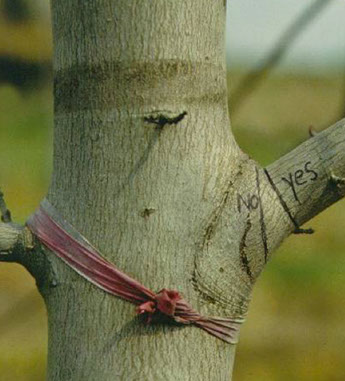
Collar >
Branch
Bark Ridge >
The final pruning cut should be just outside the Branch Bark Collar -- cutting into the collar amounts to cutting into the trunk.
Shrub Pruning:
Properly pruned ornamental plants look more attractive, grow healthier and more vigorously, and improve the overall value of your property. Pruning also reveals the natural branch structure, prolongs flower production, and improves clearance and visibility on your property.
Although pruning shrubs is a simple concept, it is crucial that it be done correctly and at the right time. At Almstead, we offer a customized, hand-pruning program for your shrub material. Each visit is specifically tailored to address your shrub collection and their individual bloom cycle. We can also include to prune perennials, if desired. Here's what we can do for your shrubs:
Early Spring (Mid-March to Mid-April)
At this time, we prune away dead, broken and diseased branches and any winter damage. We also prune to shape each shrub tailored to its species and bloom cycle. Partial list of shrubs to prune: crape myrtle, butterfly bush, barberry, burning bush, viburnum, repeat blooming roses, 'peegee' hydrangea...
Summer (August to Early-September)
In late summer, we focus on reducing and shaping the second flush of growth, and removing dead, broken or diseased plant parts. Partial list of shrubs to prune: select Hydrangea, Privet, select Evergreens...
Fall (October to Mid-November)
At this time, we focus on select pruning as required for prepping for dormancy. We concentrate on removing dead, broken or diseased plant parts and restoration and rejuvenation pruning to prepare for winter and spring growth based upon species.
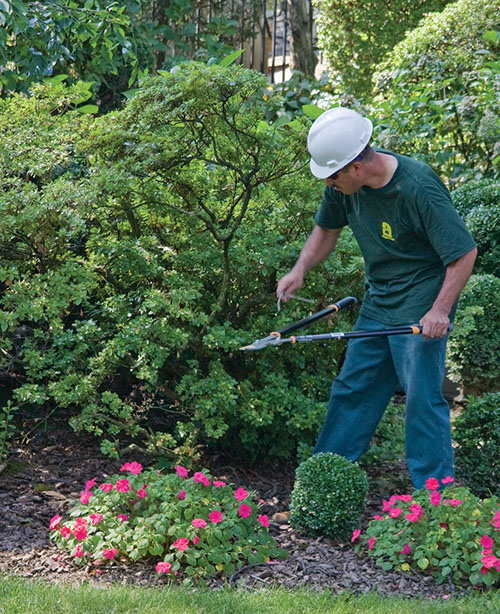
Lower Westchester 914-576-0193 I Upper Westchester 914-741-1510 I Fairfield County, CT 203-348-4111 I Bergen & Passaic County, NJ 973-636-6711
Make a Payment I Careers at Almstead I Commercial Care I Tree Care I Lawn Care I Plant Health Care I Organic I Consulting I Nursery & Mulch I Insect Control I Newsletter I Contact Us
Copyright 2023 Almstead Tree, Shrub & Lawn Care Company I All rights reserved I Content on this site cannot be used without permission.


